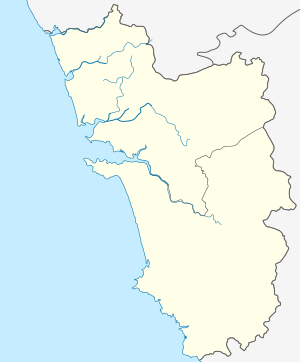Colvale Fort (Goa)
O Fortaleza de São Sebastião de Tivim, also called the Tivim fort after the village where a part of the long wall structure was once located. Also referred to as the Middle Fort or Fortress Tivim. The structure spans from the village of Tivim, to the area known as Colvale, in the State of Goa, on the west coast of India. Currently, most of it is in ruins and barely visible. However, parts of the structure are in the process of being restored.
| Fortaleza de São Sebastião de Tivim | |
|---|---|
Portuguese: Fortim Tivim / English: Tivim Fort | |
| Part of Portuguese Goa | |
| Tivim, Goa, India | |
 Fortaleza de São Sebastião de Tivim | |
| Coordinates | 15.6492389°N 73.8341908°E |
| Code | IN-GA |
| Site information | |
| Owner | |
| Controlled by | |
| Open to the public | Yes |
| Condition | Ruins |
| Site history | |
| Built | 1635-1681 |
| Built by | Portuguese India |
| Materials | Brick and Stone fort |
| Demolished | Abandoned in 1841 |
History
This fortification was built in 1635 on the orders of the then Viceroy of the Estado Português da Índia, D. Miguel de Noronha, conde de Linhares. The fortifications were completed in the year 1681 by the Count of Alvor as a barrier to safeguard the Bardez frontier against the Marathas and Bhonsles. The fortifications consisted of a canal with a high wall on its western bank which served as a moat. It also consisted of a series of guard houses at least three of which are still identifiable ruins.
In the year 1739, it was annexed by the Maratha warriors and after 2 years it was recaptured by Luís Carlos Inácio Xavier de Meneses, 1st Marquis of Louriçal. The fortification was garrisoned by Portuguese troops until they were withdrawn in 1841 when they were moved to they nearby town of Mapuca. Mapusa The fortification gradually lost its strategic importance; it had for a few years been abandoned and neglected. It is now being restored under the auspices of the Directorate of Archives and Archaeology in Goa.[1]
Inscription
On its gates, an epigraphic inscription read:
(Portuguese: "In the reign of the Catholic king Filipe XIIIX, the Governor of this State Miguel de Noronha, Count of Linhares, undertook this work. 1635.")Reinando O Catholico Rei Dõ Fillipe X3X Governando Este Estado O Vigilãtissimo Dõ Miguel De Noronha Conde De Linhares Se Fez Esta Obra 1635.
Protected site
The ruins and site of the fort have been protected by the Government of Goa, Daman and Diu (now the Government of Goa) as a historical heritage site since 1983.[2]
Architecture
The fort shows the influence of both Portuguese and Hindu architecture. During the Marathas's stay at this fort, they re-designed some parts of the monument based on the local architectural style. Though much of the fort is in ruins, its structural importance can still be comprehended.
The fortress was primarily built of brick and stone and mud and was a long wall which ran alongside the western bank of a canal. In addition, there were at least three guardhouses which contained forces to guard the area. On the exterior the fort had high walls to stop enemies from crossing into the area, known as Bardez. It is believed that the interior of the fort once had the bastions and cannons of the Marathas and the Portuguese rulers, but since most of the fort is ruined in the present day, very few traces of them remain to be seen.
Location
The fort area is located in Survey No. 74 Subdivision 23 of Colvale village in Bardez, and the land is owned by the government of Goa.[3]
Nearby stands the Church of Colvale, founded by the Franciscans in 1591, rebuilt in 1678 and renovated after the fire it suffered during the invasion of Marathas forces under the command of Sambhaji in 1683.
Bibliography
- Mendes, António Lopes. A India portugueza: breve descripção das possessões portuguezas na Ásia. Asian Educational Services, 1989. ISBN 8120604717.
References
- Archives Archichologicalhttp://daa.goa.gov.in
- "Ancient Monuments and Archaeological Sites" (PDF). Goa Printing Press.
- http://www.daa.goa.gov.in/monuments.php
Archives Archichologicalhttp://daa.goa.gov.in